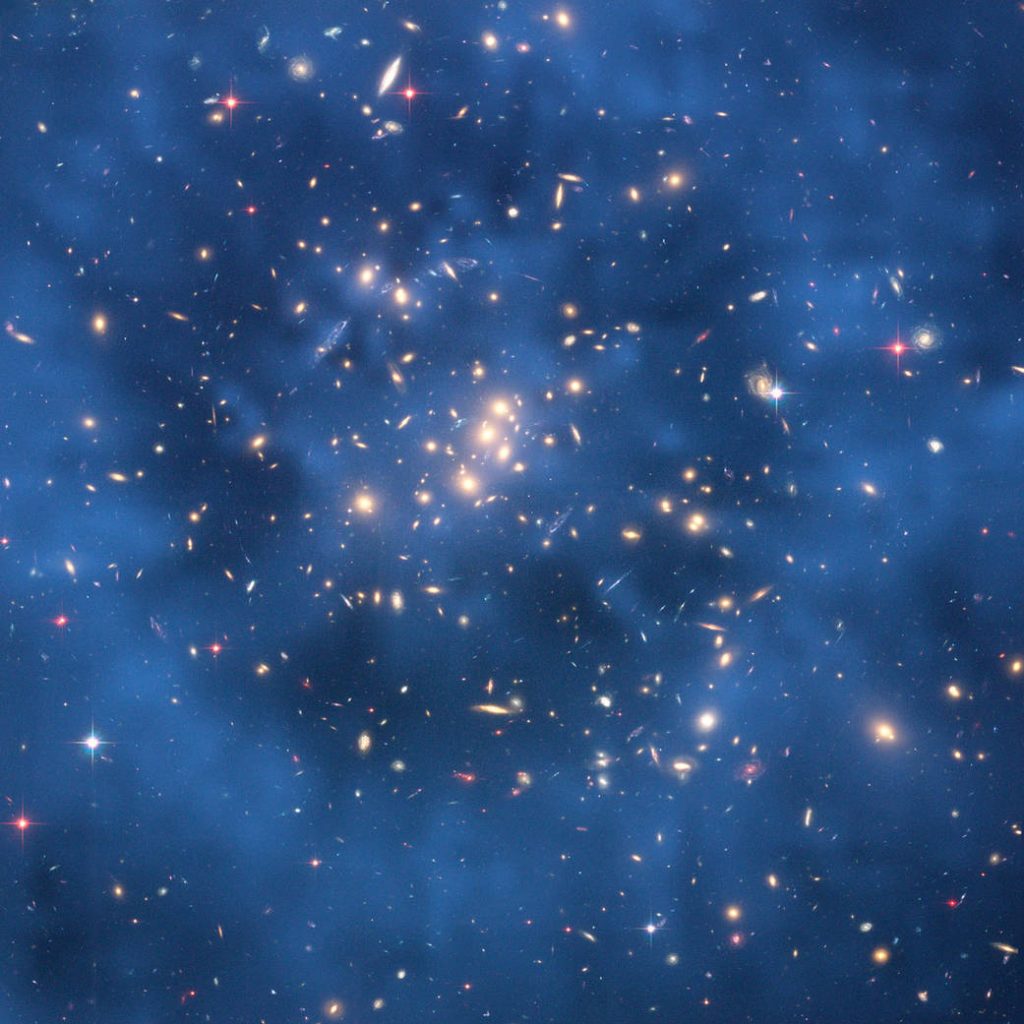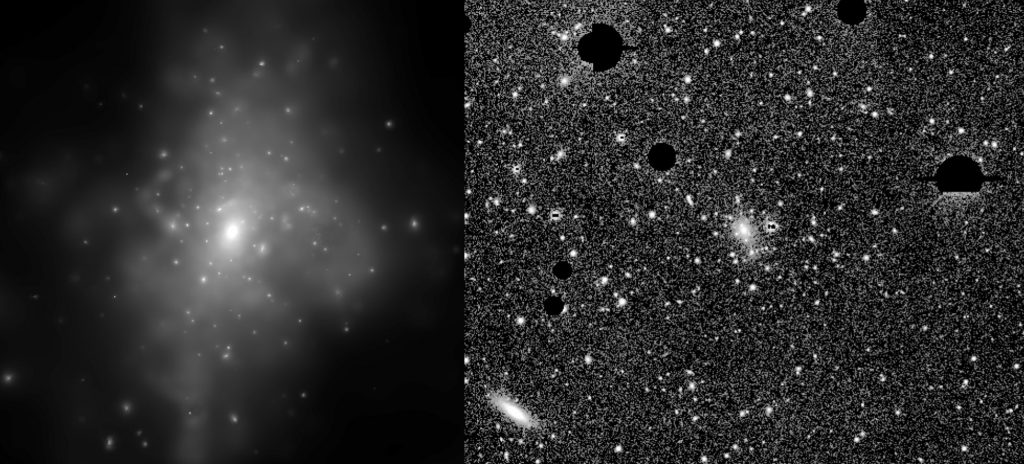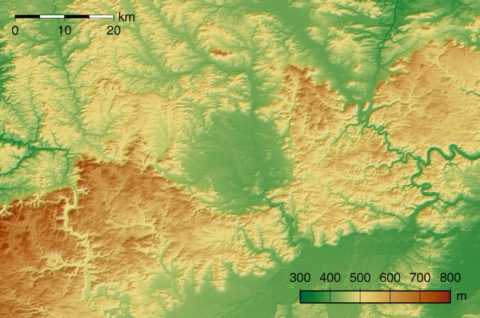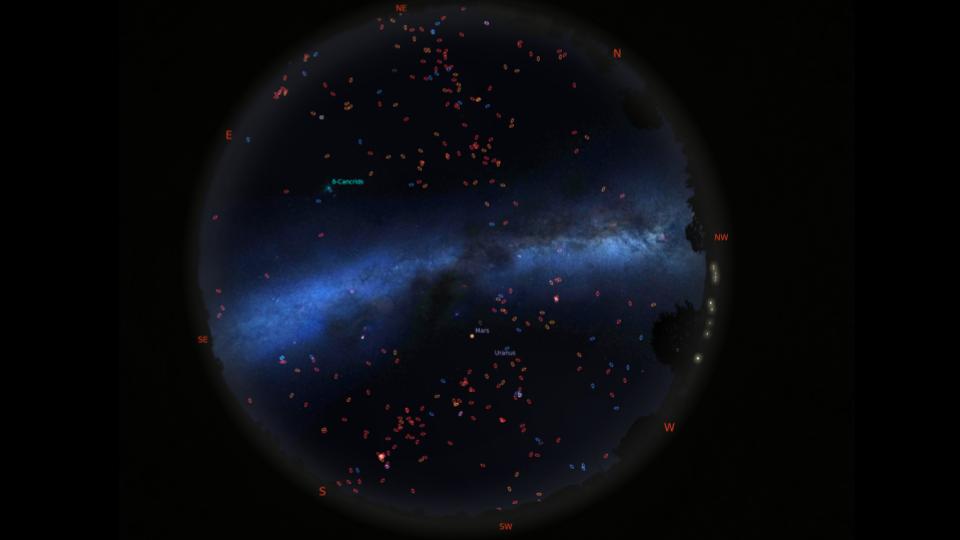Summary
Dark matter is only acted upon by the force of gravity according to new research, which constrains the potential range of mass for the elusive particles. Plus, how precipitation affects the Earth’s crust, a pair of ancient asteroid impacts in Germany, NASA’s Day of Remembrance, and this week’s What’s Up.
Media
Transcript
Hello and welcome to the Daily Space. I am your host Dr. Pamela Gay, and I am here to put science in your brain.
And yesterday a short little letter filled with equations broke my brain with science. Researchers Xavier Calmet and Folkert Kuipers have a new work accepted into the journal Physics Letters B, and in it, they work out new limits on the mass of individual particles of dark matter.
As the name implies, dark matter is stuff that doesn’t interact with or emit light. It makes up about 27% of the universe, and because it only seems to interact via gravity, it is super hard to understand.
According to Calmet:
This is the first time that anyone has thought to use what we know about quantum gravity as a way to calculate the mass range for Dark Matter. We were surprised when we realised no-one had done it before – as were the fellow scientists reviewing our paper.
What we’ve done shows that Dark Matter cannot be either ‘ultra-light’ or ‘super-heavy’ as some theorise – unless there is an as-yet unknown additional force acting on it. This piece of research helps physicists in two ways: it focuses the search area for Dark Matter, and it will potentially also help reveal whether or not there is a mysterious unknown additional force in the universe.

The limits they derived put the mass-energy of any dark matter particles between 10-3 eV and 10^7 eV. To put this in context with other particles, they find dark matter should have masses in the same range as the various masses of neutrinos or electrons.
This consistency with neutrino masses is particularly tantalizing to me. While not discussed in this paper, many researchers have wondered if the annoyingly difficult to observe neutrino could be related to or a form of dark matter. This work doesn’t rule out that possibility.
To get at these limits, Calmet and Kuipers considered factors such as how fast would particles of different sizes decay? How big must it be to not require additional forces? And even what limits are created by high school chemistry concepts like the Pauli Exclusion Principle. While this is a very elegant paper, it does have limits. At the most simplistic level, there could be physics at play that we don’t know about, and some of the assumptions they made, such as quantum gravity following the traditional Plank scale, could be wrong.
But this is the first step, and this first step seems to confirm that dark matter can be explained with known physics as a particle of reasonable size and that we just may be following the right path toward its discovery.
While some scientists look to define dark matter from theoretical physics, others are out there trying to understand it from how it moves luminous matter.
Dark matter is pretty much everywhere in our universe, but it has its highest densities in galaxy clusters. This has been determined by looking at how the gravitational pulls of dark matter twist the light of background objects. While this technique, called weak lensing, can get us good information on the distribution of dark matter, it doesn’t give us a very detailed image.

Coming to the rescue is intracluster light: light from stars that have been torn from galaxies and are now living in the spaces between galaxies. This light is extremely faint and requires near Herculean observing efforts to see. The Dark Energy Survey, with its sensitive camera and long observations, has taken on this task and found gold or at least intracluster light. Researcher Yuanyuan Zhang explains: Observationally we discovered that intracluster light is a pretty good radial tracer of dark matter. That means that where intracluster light is relatively bright, the dark matter is relatively dense.
These results were checked against weak gravitational lensing results, and everything matched.
This work combines data from 500 different clusters within 3.3 billion light-years and helps us understand how dark matter is distributed in our modern universe. Seeing intracluster light in more distant galaxies is a goal for this team. Since the light from distant clusters has been traveling for longer, we can essentially look back in time by looking at farther away systems.
In this case, distant clusters could allow us to understand how the distribution of dark matter has changed over time. Zhang goes on to say: My dream is to go all the way to … 10 billion light-years. Studies say that’s when the ICL has just started to evolve.”
Getting the dreamed-of data won’t be easy, but we don’t do science because it’s easy. We wish Zhang and her team clear skies.
In a previous episode, we talked about how geologists use Global Navigation Satellite Systems to measure changes in the surface of the Earth, especially in areas that have regular earthquakes. There is an entire system called the Network of the Americas (NOTA) that has GPS and GNSS stations all along the west coast of the United States and down into the Caribbean, and the data taken from these stations is collected continuously. This process allows scientists to understand the interactions between various plate boundaries, such as the San Andreas Fault in California.

Now scientists have taken all of that data collected between 2007 and 2019 in much of California and compared the results to meteorological data from the same time period. The question the team was seeking to answer was if long-term weather pattern changes, such as the multi-year drought from 2012 to 2015, had an effect on the amount of deformation the region experienced. And the short answer was “yes.”
Prior to this study, published in JGR Solid Earth, scientists had come to understand that short-term, seasonal changes in the weather had an effect on crustal deformation and even impacted the local earthquakes. Basically, the ground compacts during wet, winter months, like now, and rebounds during the dryer, summer months. So what happens when the area doesn’t get much rain for three years? The usual rebound, or dilation of the crust, was half what it was in normal wet years.
Apparently, you can’t get a pull without much of a push first. More research is needed to understand just how these long-term variations in the weather actually affect the earthquakes in the region, though. We’ll keep you informed of any new developments.
Earthquakes are just one of the ways the Universe is trying to kill us, and it’s a relatively tame method compared to the Universe sending rocks at the surface of the planet. Just one big rock, and bye-bye, dinosaurs!

Then you take a look at the surface of the Moon and think, that’s a lot of craters! Good thing Earth doesn’t look like that. Except that it kind of does, and we hide it really well with vegetation and erosion. Still, it’s a bit shocking to find two large craters close to one another here on Earth, and for a long time, scientists thought that these double craters were the result of binary asteroids — two asteroids orbiting each other that hit the Earth at about the same time.
That hypothesis was disproved because binary asteroids orbit each other too closely to leave separate craters. They would have to enter our atmosphere separately, and that’s not a likely scenario.
Now, in recent research published in the journal Scientific Reports, a team led by Elmar Buchner has analyzed two craters in Germany to understand their provenance. One of the two is the 24-kilometer Ries crater that encompasses the town of Nördlingen, and the other is the 4-kilometer Steinheim Basin, about 40 kilometers away. The team found that the Ries crater is about 11.8 million years old, and the Basin is thought to be about the same. Plus, the rocks in the area show evidence of two separate seismic events, which means that the region got a one-two punch of asteroid strikes, maybe a couple hundred thousand years apart.
Planetary scientist William Bottke, who has studied double craters but wasn’t involved in this particular research, noted: If you only have so much terrain and you keep adding craters, eventually, two are going to be very close to one another, just by chance.
Sorry, Germany.
We talk a lot on Daily Space about how “space is hard.” It’s a mantra of sorts when it comes to failed rocket launches and test flights. Unfortunately, we’ve lost people to the cause of advancing space science and engineering.

Today is NASA’s Day of Remembrance, and we honor the sacrifices and memories of those who gave their lives in the Apollo 1, Challenger, and Columbia missions.
First, we honor Gus Grissom, Ed White, and Roger Chaffee, the Apollo 1 astronauts lost when a fire broke out in the Apollo capsule during a pre-launch test on January 27, 1967.
Next, we honor the crew of the space shuttle Challenger, which broke apart 73 seconds after launch on January 28, 1986, 35 years ago today. Those astronauts were Mission Specialist Ellison Onizuka, Pilot Michael Smith, Payload Specialist Christa McAuliffe, Commander Dick Scobee, Payload Specialist Gregory Jarvis, Mission Specialist Judith Resnik, and Mission Specialist Ronald McNair.
Finally, we honor the crew of the space shuttle Columbia, who were lost on February 1, 2003, when the shuttle broke up upon re-entry. Those astronauts were Mission Specialist David Brown, Commander Rick Husband, Mission Specialist Laurel Blair Salton Clark, Mission Specialist Kalpana Chawla, Payload Commander Michael Anderson, Pilot William McCool, and Payload Specialist Ilan Ramon.
Space is hard, and astronauts know they could die. They are a new kind of test pilot, and it is on us to never take them for granted or stop striving to over-engineer toward success. Their sacrifices led to improvements in spacecraft design and procedures for protecting future crews. As NASA’s Acting Administrator Steve Jurczyk writes: As we work to achieve our goals of putting the first woman and next man on the Moon and send the first humans to Mars, let us pause for a moment to remember…
[Please take a moment to pause and reflect on the sacrifices these astronauts made.]
What’s Up
The brightest object in the night sky is the Moon, and tonight, it’s Full. This particular full moon has several names: the Wolf Moon, the Snow Moon, or the Hunger Moon. All these names evoke feelings of deep winter and isolation here in the northern hemisphere.

Well, okay, we get Snow Moon and Hunger Moon. But Wolf Moon? Where does that name come from? Are we thinking of a lone wolf howling in the winter night? Or a pack of wolves hunting outside a hungry, cold village? There’s an easy tendency to think that it’s a Native American name, but that actually isn’t the case. According to an article in Indian Country Today, the closest known Native American name for this full moon is Wolves Run Together Moon from the Sioux.
Other tribes have different names, of course, and we’re not going to attempt the native versions out of respect for the beauty of their languages. So here are some translated names. The Algonquin call this moon Sun Has Not Strength to Thaw. In Alaska, the Haida call it Bear-Hunting Moon. In southwest Arizona, the Hopi called it Moon of Life at its Height. In the Pacific Northwest, the name is Stay Inside. And the Choctaw in the south call this moon Winter’s Little Brother.
What’s your favorite name? Personally, I like Moon of Life at its Height. I feel almost energized hearing that name. I suspect there is some influence of cold desert nights and pleasant winter days on that name. Although Stay Inside is good, too: simple, succinct, and honest. Between the rain in California and the snow in Illinois almost everywhere else, staying inside sounds like a good plan.
Whatever you call it, make sure you take a look at it, and may it bring you joy during these long winter nights. (Or, if you’re in the southern hemisphere, may it bring you joy on these hot summer nights.)
That moon that is so very beautiful also makes seeing anything faint in the sky nearly impossible, and the best things in the sky right now are faint galaxies.
One of the things we just don’t think about a lot is how we live inside a massive disk of stars, and as our planet swings around the sun, the part of that disk that we can see changes. Right now, we are looking away from our galaxy’s center. The band of the Milky Way that passes near Orion as it spills across the sky is thinner and fainter than when we’re looking toward the Milky Way’s center in the summer. For folks like me, who have done work observing galaxies, now is the time of year to spend at an observatory because we have a much clearer view out of our galaxy to all the other galaxies out there.

The Andromeda galaxy is one of those many galaxies out there right now, shining just bright enough to be seen with your eyes if there is no Moon, which we have right now.
If you still want to try and see Andromeda with your eyes, one of the best tools to help is an app like Sky Safari that can use the GPS and sensors in your phone to figure out what part of the sky is behind your phone. There is a lot of different software that can do this, but I have a soft spot for Sky Safari because it’s not only easy to use but because the company behind Sky Safari has donated back proceeds from their sales to astronomy education many different times over the years. If you have clear skies now, get used to using the software to understand how to find bright objects like Mars, and then, when that pesky Moon goes away, you’ll be ready to find amazing dark sky objects like the Andromeda Galaxy.
For now, though, we have the Moon.
As a side note, we recorded this episode at 1 pm Eastern, and at that time SpaceX was planning a test of their Starship SN9. We don’t know how this went [Ed. note: It didn’t go.] but want to remind everyone that space is hard, and it is amazing what humans are capable of. Even when we fail, we keep going and we keep trying to accomplish more and more.
This has been the Daily Space.
Learn More
Narrowing the Mass Range of Dark Matter Particles
- The University of Sussex press release
- “Theoretical bounds on dark matter masses,” Xavier Calmet and Folkert Kuipers, 2021 March 10, Physics Letters B
Intracluster Light Possible Linked to Dark Matter
- Fermilab press release
- “Is diffuse intracluster light a good tracer of the galaxy cluster matter distribution?“, H Sampaio-Santos et al., 2020 November 26, Monthly Notices of the Royal Astronomical Society
Assessing How Long-Term Weather Patterns Affect Crustal Strain
- Eos article
- “Crustal Strain Patterns Associated With Normal, Drought, and Heavy Precipitation Years in California,” Jeonghyeop Kim, Alireza Bahadori, and William E. Holt, 2020 December 2, Journal of Geophysical Research: Solid Earth
Germany Struck by Double Asteroids in Miocene
- Eos article
- “New discovery of two seismite horizons challenges the Ries–Steinheim double-impact theory,” Elmar Buchner, Volker J. Sach and Martin Schmieder, 2020 December 17, Scientific Reports
NASA Pays Tribute on Day of Remembrance
What’s Up: Wolf Moon and Galaxies
- EarthSky article
- Indian Country Today article
- Sky at Night article
Credits
Written by Pamela Gay and Beth Johnson
Hosted by Pamela Gay
Audio and Video Editing by Ally Pelphrey
Content Editing by Beth Johnson
Intro and Outro music by Kevin MacLeod, https://incompetech.com/music/





 We record most shows live, on Twitch. Follow us today to get alerts when we go live.
We record most shows live, on Twitch. Follow us today to get alerts when we go live.